LABOUR WELFARE & INDUSTRIAL RELATIONS
Paper – II
Note : This paper contains fifty (50) objective type questions of two (2) marks each. All questions are compulsory.
1. Examine the following statements about Scientific Management and identify those which are true and false.
a. The term ‘Scientific Management’ was not coined by Frederick Winslow Taylor.
b. Henry R. Towne’s ‘Engineer as a economist’ influenced Taylor’s ideas.
c. ‘Shop Management’ embodies ‘Therbligs’.
d. Louis D. Brandies heard the case filed against Taylor’s Scientific Management by Trade Unions.
Codes :
(1) a, b, c are true and d is false.
(2) a, b, d are true and c is false.
(3) a, b are true and c, d are false.
(4) a, c are true and b, d are false.
2. Which of the following statements about open systems as given by Daniel Katz and Robert Khan are true ?
a. The exportation of energic inputs into the environment.
b. Transformation of available energy as throughput, so that work is done.
c. The importation of the output from the environment.
d. A cycle of events in which the product exported to the environment provides the energy for repetition of the cycle.
Codes :
(1) a, b
(2) b, c
(3) b, d
(4) a, d
3. Match the following :

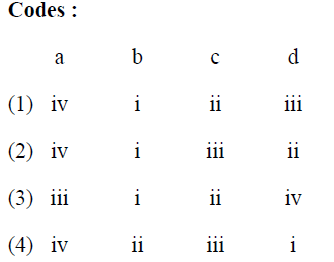
4. Match the following activities (List-I) with the degree of delegation (List-II).

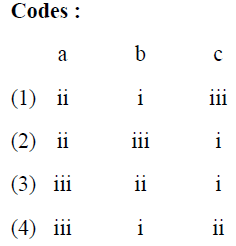
5. The steps in planning process are jumbled up. Arrange them in correct sequence.
a. Specifying alternatives
b. Analyzing alternatives
c. Goal setting
d. Elaborating plans and specifying details
e. Establishing standards for measurement
f. Maintaining communication
g. Maintaining a time perspective
h. Planning for unpredictable contingencies
i. Organising
j. Implementing
k. Ensuring Participation
l. Follow-up, providing for flexibility
Codes :
(1) c, e, g, a, b, d, k, f, i, j, l, h
(2) c, a, g, b, d, k, f, j, i, h, l, e
(3) d, c, a, f, g, i, b, e, l, h, j
(4) c, g, e, b, a, k, d, i, f, j, l, h
6. Match the following HRM models (List-I) with their themes (List-II) :


7. Which of the following statement/s is/are true ?
a. Configurational or bundle theorists propose that there are ideal types of configurations of HR practices that promote synergies.
b. High performance work systems combining information sharing, decentralized decision making via teams; participative management at operational, tactical and strategic levels are, however not part of the configurational framework.
Codes :
(1) only a
(2) only b
(3) both a and b
(4) neither a and b
8. Read the following statements about ‘staffing’ as a strategy formation. Identify the ones which are true.
a. Organisations need to hire ‘best’ people emphasizing person-organisation fit over person-job fit.
b. Organisations need to hire people with unique as well as complementary KSAs in order to have the capability to implement flexible and focused business strategies in a fast changing environment.
c. Organisation need to hire people with talent and creativity to contribute to business strategies in a manner that will take any possible course of action in any direction.
Codes :
(1) only a
(2) a, b
(3) b, c
(4) a, b, c
9. Which of the following is not a best practice in High Commitment Pay ?
(1) High wage policies to attract, retain and motivate the best talent, that is based on the belief that, ‘You get what you pay for’.
(2) Employment security is essential to be the ‘employer of choice’ and it is the bed rock for high quality work and a willingness to be flexible and innovative.
(3) Encourage employee ownership of the enterprise.
(4) Non-egalitarian symbols and perquisites.
10. Which of the following may be a possible consequence of inter-group conflict within the involved groups ?
a. Group cohesiveness increases.
b. Group becomes task oriented.
c. Organisation structure becomes more rigid.
d. Leadership becomes more rigid.
Codes :
(1) a, b and d
(2) b, c and d
(3) a, b, c and d
(4) a and b only
11. Assertion (A) : Master-Servant doctrine believed in the inalienable prerogative of Master’s will with regard to servant’s continuance in employment.
Reason (R) : This prerogative has been granted by the sanction of law made by the State Power.
Codes :
(1) (A) and (R) are wrong.
(2) (A) is wrong and (R) is right.
(3) (A) and (R) are right, but (R) does not justify the Assertion (A).
(4) (A) is right, but (R) is wrong and does not justify the (A).
12. Match the contributors (Behavioural Scientists) List-I with their contributions given in List-II.

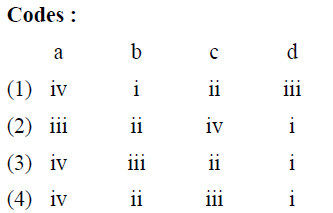
13. Which of the following is not a Simulation technique of development ?
(1) Management Games
(2) Case Study
(3) In-basket
(4) Sensitivity Training
14. Which of the following statements is/are true and false ?
a. If motivation is low, monotony (mental fatigue) grips very early.
b. If motivation is high, the will and desire to work increases and both fatigue and monotony decreases.
c. Highly intelligent people are more susceptible to monotony if subjected to repetitive work, because their level of expectations from job towards meaningfulness is low.
d. The anticipation of the end of the work period tends to abolish signs of monotony.
Codes :
(1) a and d are true; b and c are false.
(2) a and c are true; b and d are false.
(3) a, b and d are true; and c is false.
(4) b, c and d are true; and a is false.
15. Consider the following statements :
a. Conflict that supports the goals of the group and improves its performance.
b. Conflict that hinders group performance.
c. Emotional involvement in a conflict creating anxiety, tenseness, frustration, or hostility.
d. Withdrawal from or suppressing conflict.
The above statements, in correct sequence (a, b, c, d) refer to :
Codes :
(1) Dysfunctional, functional, inter-group, and approach-approach conflict respectively.
(2) Functional, Dys functional, Felt conflict and avoidance respectively.
(3) Functional conflict, confrontation strategy, Perceived and manifest conflict respectively.
(4) Inter-group conflict, dysfunctional conflict, Goal Diversity and Containment Strategy.
16. In Transactional Analysis, if the response is by the same ego state as through which the message was received, the transaction is called
(1) Crossed Transaction
(2) Complementary Transaction
(3) Ulterior Transaction
(4) Feed-forward Transaction
17. “Healthy people show the behaviour of maturity, while unhealthy people tend to demonstrate child like immature behaviour.”
Who among the following behavioural Scientists said this ?
(1) John Berry
(2) Blake and Mouton
(3) F.W. Taylor
(4) Chris Argyris
18. Which of the following statements are true/false ?
a. Maslow’s need theory considers needs to explain human behaviour.
b. Mc Gregor’s theory considers opposite perceptions based on managerial assumption of employee behaviour.
c. Vroom’s theory considers force, valence, expectancy, and instrumentality to explain motivation.
d. Cognitive evaluation theory classifies persons as intrinsically and extrinsically motivated.
Codes :
(1) a and d are true, c and b are false.
(2) a, b and d are true, c is false.
(3) a, b, c and d are true.
(4) a and c are true, b and d are false.
19. The following three types of tests namely objective tests, projective tests, and situation tests are basically used as tools of
(1) Intelligence tests
(2) Personality tests
(3) Cognitive ability test
(4) Competency mapping
20. ‘Alarm Reaction’, ‘Stage of Resistance’ and ‘Stage of Exhaustion’ are the stages of which of the following syndromes :
(1) Buggy-whip Syndrome
(2) Dissociative Identity Disorder Syndrome
(3) General Adaptation Syndrome
(4) Amoeba Syndrome
21. Who is/are the author (s) of the books titled, ‘A History of Trade Unionism’ (1897) and ‘Industrial Democracy’ (1902), the two early writings on Industrial Relations ?
(1) Sidney and Beatrice Webb
(2) Alan Fox and Allan Flanders
(3) Karl Marx
(4) H.A. Clegg
22. The Descending Participation i.e., Workers’ participation in work was propounded by
(1) The Fabians
(2) The Harvard Group
(3) The Oxford Group
(4) The Tavistock Group
23. Match the themes of the three approaches of industrial relations under contradictions perspective :

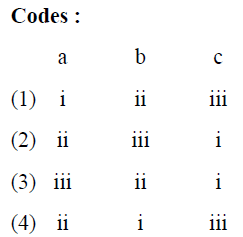
24. Which of the following is not an industrial union ?
(1) The Engineering Mazdoor Sabha
(2) The Rohtas Workers’ Union
(3) The Girni Kamgar Union
(4) The Rashtriya Mill Mazdoor Sangh
25. Who has viewed collective bargaining as a process of social change ?
(1) Neil W. Chamberlain
(2) J.H. Richardson
(3) Arthur D. Butler
(4) H.W. Davey
26. Which of the following is not included in the ‘illustrative list of items’ approved by the Indian Labour Conference pertaining to the items which the Works Committees will normally deal with ?
(1) Amenities such as drinking water, canteens, creches,medical, and health services.
(2) Quantum of leave and national and festival holidays.
(3) Adjustment of festivals and national holidays.
(4) Safety and accident prevention, occupational diseases and protective equipment.
27. Which of the following was formed in the year 1945 ?
(1) International Federation Chemical, Energy, Mining and General Workers.
(2) International Confederation of Free Trade Unions.
(3) World Federation of Trade Unions.
(4) International Federation of Christian Unions.
28. Who among the following were moderates in the context of trade union movement in India ?
(1) B.T. Ranadive and S.V. Deshpande
(2) Diwan Chamanlal and N.M. Joshi
(3) M.N. Roy and Maniben Kara
(4) H.K. Mehtab and Dattopant Thengadi
29. When a strike is conducted with a view to force an employer to recognise or bargain with a particular trade union instead of another, such strike is called as
(1) Political strike
(2) Ordinary strike
(3) Protest strike
(4) Jurisdictional strike
30. Which of the following pairs is not correctly matched ?
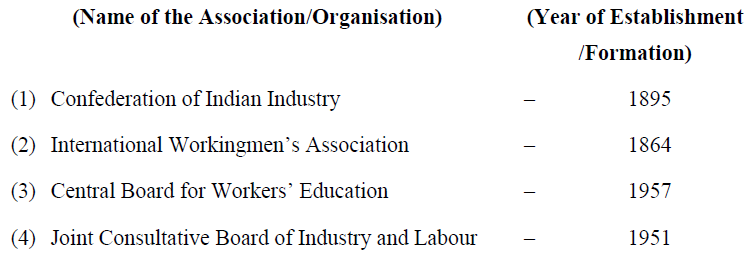
31. According to William Beveridge which of the following are not part of a comprehensive social security scheme ?
a. Social assistance
b. Compulsory insurance
c. Social insurance
d. Voluntary insurance
e. Voluntary assistance
Codes :
(1) b and e only
(2) d and e only
(3) b, d and e only
(4) a, b and d only
32. A trade Union has been formed in an establishment employing five hundred employees.
What is the minimum number of members it should have to apply for registering it under the Trade Unions Act, 1926 ?
(1) Seven members
(2) One hundred members
(3) Fifty members
(4) Seventy members
33. Under the Industrial Disputes Act, 1947, to which of the following industrial undertakings the provisions relating to lay-off, retrenchment and closure provided under chapter V-B shall be made applicable ?
(1) Industrial establishment in which not less than one hundred workmen were employed on an average per working day for the preceding twelve months.
(2) Industrial establishment in which not less than one hundred workmen were employed on an average per working day in the preceding calendar month.
(3) Industrial establishment in which not less than one hundred workmen were employed on an average per working day during the preceding calendar year.
(4) Industrial establishment in which not less than one hundred workmen were employed on an average for the preceding three months.
34. As per the Government of India notification the wage limit for employees to be covered under the Employees’ State Insurance Act, 1948 is proposed to be increased to
(1) Rupees Eighteen thousand
(2) Rupees Twenty-five thousand
(3) Rupees Twenty thousand
(4) Rupees Twenty-one thousand
35. Under the Minimum Wages Act, 1948 what is the extent of representation of Independent persons in the Advisory Committee ?
(1) one-half of its total members.
(2) one-third of its total members.
(3) one-fourth of its total members.
(4) one-half of its total members subject to a maximum of light.
36. If any dispute arises regarding the payment of subsistence allowance to a workman under the provisions of the Industrial Employment (Standing Orders) Act, 1946, then the dispute may be referred to !
(1) Certifying Officer appointed under the Industrial Employment (Standing Orders) Act, 1946.
(2) Enquiry Officer appointed to enquire the allegations framed against the workman.
(3) Chief executive of the industrial establishment in which the workman is employed.
(4) Labour court constituted under the Industrial Disputes Act, 1947
37. What is the minimum period an employee should have worked in an accounting year in an establishment to become eligible for bonus under the payment of Bonus Act, 1965?
(1) Forty five days
(2) Thirty days
(3) Sixty days
(4) Ninety days
38. Which of the following statements relating to the Constitution of the Advisory Committee under the Equal Remuneration Act, 1976 is true ?
(1) It shall consist of not less than twelve persons of which one-third shall be women.
(2) It shall consist of eight persons of which one-half shall be women.
(3) It shall consist of not less than ten persons nominated by the appropriate Government, of which one-half shall be women.
(4) It shall consist of twelve persons nominated by the Central Government of which one-third shall be women.
39. Match the propounders mentioned in List-I with the theories of wages mentioned in List-II.
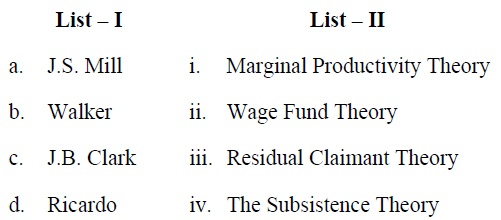
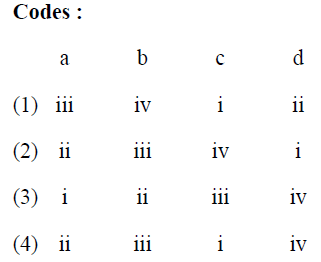
40. Under which of the following legislations the provision for payment to any trade union fee on a written authorisation from an employee has been provided ?
(1) Industrial Disputes Act, 1947
(2) Trade Unions Act, 1926
(3) Payment of Wages Act, 1936
(4) Industrial Employment (Standing Orders) Act, 1946
41. Match the Principles of Labour Welfare mentioned in List-I with the contents given in List-II.
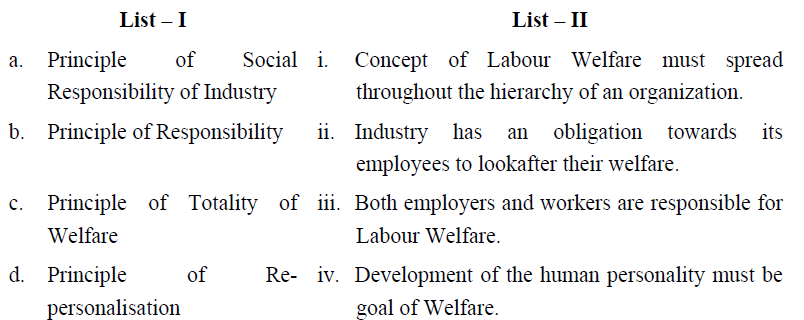
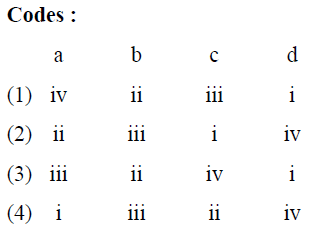
42. Which among the following statements is not true is relation to Labour Welfare ?
(1) Labour Welfare is an essential part of Social Welfare.
(2) Labour Welfare Work not only covers the work life of workers in the factory but also extends beyond into his life with his family and community.
(3) Labour Welfare is not concerned with desirable conditions of existence, biologically and Socially determined.
(4) Labour Welfare is a relative concept, relative in time and place.
43. Which one of the following does not constitute to be a direct source of Industrial Jurisprudence in India ?
(1) The Constitution of India
(2) Legislative enactments
(3) International obligations
(4) Judicial decisions
44. Who was the first person to advocate an eight hours working day for workers ?
(1) Robert Owen
(2) John Stuart Mill
(3) George Elliot
(4) August Comte
45. Assertion (A) : Welfare is a relative concept, relative in time and place.
Reason (R) : Ideas of Welfare differ with passage of time. Man accepted comparatively less convenient and less sumptuous conditions of existence; for Science and Technology had not made possible better amenities. Then again, meaning and content of Welfare differs from country to country or region to region.
Codes :
(1) (A) is correct, but (R) partially explains (A).
(2) (A) is partially correct and therefore, (R) only partially explains (A).
(3) (A) is correct and (R) explains (A).
(4) (A) is wrong and (R) is partially correct.
46. Labour Welfare Services were divided into two groups by the committee of experts on Welfare facilities for Industrial Workers convened by ILO in 1963. These are (a) Those within the precincts of the establishment and (b) Those outside the precincts of the establishment. The content of Welfare activities remained the same as recommended by 1959 study team.
As per the ILO classification, which one among the following is not Welfare and Amenities outside the precincts of the establishment.
(1) Social insurance measures including gratuity, pension and provident fund.
(2) Housing facilities.
(3) Recreation facility.
(4) Arrangement for prevention of fatigue.
47. Which is not true in relation to State Regulation of Wages ?
(1) Internal Wage differentials are regulated by the State.
(2) The ideals of Welfare State necessitate State Regulation of Wages.
(3) It is necessary to raise the efficiency of the workers by ensuring improvements in health, productivity and distribution of income.
(4) It is necessary because of the gap existing between the marginal productivity of labour and the actual level of wages on the average.
48. Twelfth Plan has identified certain sectors that will create large employment. Which among the following sectors has not been identified ?
(1) Textiles and Garments
(2) Leather and Footwear
(3) Gems and Jewellery
(4) Health Care
49. “Marginal productivity, wages and standard of living tend to adjust to one another.”
What is true in relation to the statement ?
(1) The condition is achieved for short-run only.
(2) The condition never arrives.
(3) The condition is achieved in the long-run.
(4) The condition arrives when high wages are paid.
50. Which among the following is not a factor which will determine the level of demand for any commodity ?
(1) Price
(2) Prices of other commodities
(3) Taste
(4) Social values
Latest Govt Job & Exam Updates: